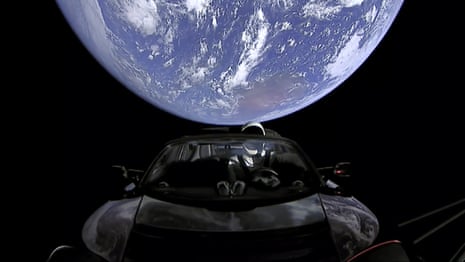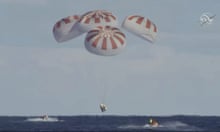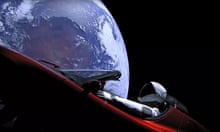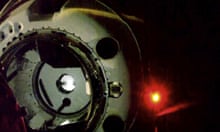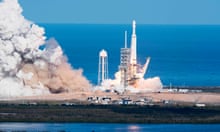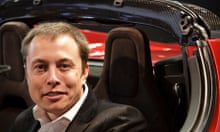It takes a beat or two for the brain to compute. The image is startling, incongruous, barmy. A car floats in space. At the wheel is a spacesuit, seatbelt on. Earth hangs behind it. The two objects don’t work together. The image jars like bad Photoshop. But it is real.
The photograph was beamed down to Earth courtesy of Elon Musk’s ego, bravado and taste for the absurd. It is human folly and genius rolled into one, a picture that sums up 2018 so far. Life on Earth feels precarious, so we look to the stars.
So how did we get here: the heavens navigated by a dummy astronaut in an electric car, with a handy note for aliens – “Made on Earth by humans” – imprinted on the circuit board?
Even Musk, engineer of the circus show, was surprised that his audacious stunt worked. “Apparently, there is a car in orbit around Earth,” he tweeted. His plan is for the $100,000 Tesla Roadster – with the message “Don’t panic!” stamped on the dashboard and David Bowie playing on the speakers – to cruise through high-energy radiation belts that circuit Earth towards deep space.
The most powerful rocket in operation
Its projected path will bring it close to Mars. There is a tiny chance it might crash into the planet. If it stays on course, it will instead drift through space, potentially for millions of years.
The Roadster was delivered into space by Musk and his company SpaceX’s biggest bet so far: the Falcon Heavy, now the most powerful rocket in operation and second only to the Saturn V rockets, which carried men to the moon during the Apollo era.
The Falcon launched from Cape Canaveral on Tuesday, watched by hundreds of thousands of people who crowded Florida’s space coast, eyes skyward.
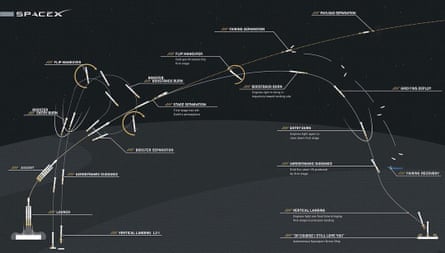
- A graphic showing the path of the Falcon Heavy rocket
But even Musk wasn’t sure it would work, putting the chance of a fully successful launch at 50%. On launch day, the company delayed for over three hours, citing high winds.
Minutes before countdown, Jeff Lucas, a Nasa communications staffer and compere of the viewing party at the Saturn V Centre, was not confident. “If it goes, don’t clap,” he told the audience. “Don’t clap until you see those orange flames clearing the tower.”
In the end, the winds died down, the sky cleared and the Falcon – shrouded in steam and mist – took off to claim its place in space and history.
Moments later the side boosters separated, beginning their choreographed dance back down to Earth. At the SpaceX launch centre, Life on Mars came on the sound system.

- Screams and cheers erupted as the massive rocket fired its 27 engines and rumbled into the blue sky. Photo by: Jim Watson/ Getty Images
The Roadster, still attached to the rocket’s upper stage, will spend hours zapped by radioactive rays in the Van Allen belts. After that, all being well, the upper stage boosters will fire one last time, pushing the Tesla out towards its elliptical orbit around Mars. If things don’t go to plan, it could orbit Earth, potentially indefinitely.
Controlled burns
Falcon’s success provides the United States with a heavy-lift capability in space not seen since the 60s – big enough to carry a car as its payload just for fun. SpaceX has landing used rockets via controlled burns down to a fine art, cutting the cost of space flight from the billions to the tens of millions (the Falcon Heavy launch cost $90m, while Nasa’s planned SLS rocket, a comparable system, is expected to cost about $1bn per flight).

- Spectators at Cocoa Beach watch SpaceX’s first Falcon Heavy rocket launch
Two of the three boosters landed safely. The third, which SpaceX had predicted was less likely to be salvaged, slammed into the Atlantic at about 300mph (483 kph).
A more worthy payload?
Musk is not without his critics. Many wondered what the point of the expensive stunt was. Should the most powerful rocket of our age not have carried a more useful, worthy payload?
Either way, the plan worked and puts SpaceX far at the front of the commercial space race.
“If we are successful, it’s game over for other operators of heavy-lift rockets,” Musk claimed before liftoff. “It’s like where one aircraft company has reusable aircraft and all the other aircraft companies had aircraft that were single-use, and you’d sort of parachute out at your destination and the plane would crash land somewhere. Crazy at it sounds, that’s how the rocket business works.”
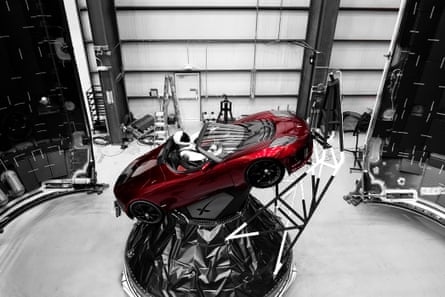
- Starman the robot in the Red Roadster car, which was inside the Falcon Heavy missile
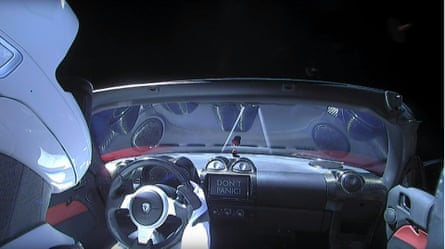
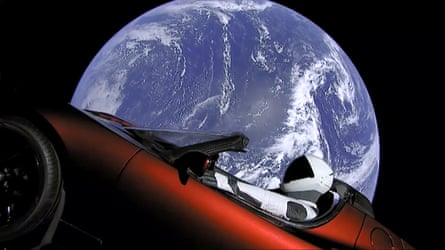
It is a long way from the failed launches of 2015, when mission CRS-7 mission was lost, and 2016, when a smaller Falcon 9 exploded on a launch zone at Cape Canaveral, forcing it to close for repairs for more than a year.
The Falcon Heavy’s successful launch propels the dream into a new orbit. Plans include building a new space station above the moon, carrying new telecom or spy satellites, and shuttling people to deep space destinations. Last February SpaceX said it intended to send two private citizens on a trip around the moon, possibly as soon as this year.
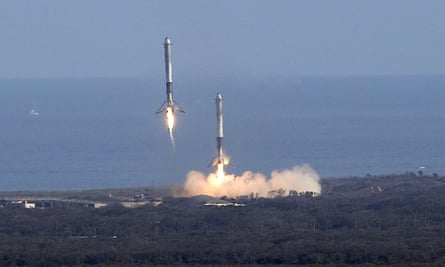
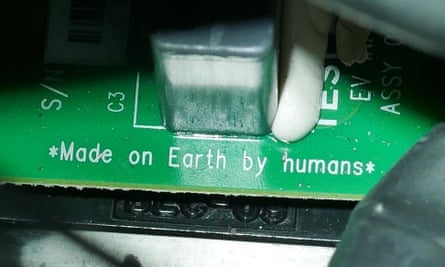


- Clockwise from top: Two booster rockets from the Falcon 9 SpaceX Heavy land at Cape Canaveral; the text printed on the circuit board of the Tesla roadster; the remaining part of SpaceX’s unpiloted supply ship, which descended in the Pacific Ocean in July 2017; a SpaceX Falcon 9 rocket breaks apart after launching in June 2015.
In the meantime, the Roadster will be ploughing its lonely course through space.
The stars look very different today.
